Review – Dexter Industries – DI Thermal Series Sensor Roundup (Updated)
I recently had the chance to test out a set of Dexter Industries Thermal Sensors produced for the NXT.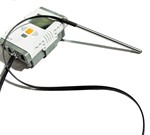 For those that are not aware, Dexter Industries has entered the market of producing LEGO Mindstorms NXT-compatible sensors and has come up with some pretty cool ideas such as the dSwitch (allows you to switch in-home devices on/off using the NXT) and some cool new ideas such as solar charging for the NXT as well as a flex sensor (stay tuned for more on this).
For those that are not aware, Dexter Industries has entered the market of producing LEGO Mindstorms NXT-compatible sensors and has come up with some pretty cool ideas such as the dSwitch (allows you to switch in-home devices on/off using the NXT) and some cool new ideas such as solar charging for the NXT as well as a flex sensor (stay tuned for more on this).
Dexter Industries Temperature Sensors
Dexter Industries offers two options; the Protected Thermal Probe (DIThermal-P) and the Open Thermal Probe (DIThermal-O). The Protected model looks a lot like the LEGO Education temperature sensor in that it has the metal tube encasing a thermistor.
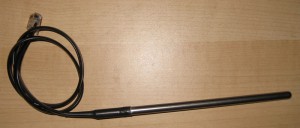 This sensor can be useful if you are monitoring liquids and need to submerge the probe (similar to what I did with my Aquasuars project). The probe is approx 6″ long (with about 16″ of cable extension). The probe diameter is not the standard LEGO Technic hole width, but, appears to be a standard size for Chemistry equipment. Temperature operating range and precision details can be found here.
This sensor can be useful if you are monitoring liquids and need to submerge the probe (similar to what I did with my Aquasuars project). The probe is approx 6″ long (with about 16″ of cable extension). The probe diameter is not the standard LEGO Technic hole width, but, appears to be a standard size for Chemistry equipment. Temperature operating range and precision details can be found here.
[ad name=”GoogleAS728x90ImgOnly”]
The Open model provides an exposed thermistor and is well sealed in shrink tubing. This sensor could be particularly useful if you wanted to insert the sensor into small LEGO elements (such as a friction peg).
Temperature Sensor Comparison
To evaluate the performance of the sensors, I pitched the sensors against the 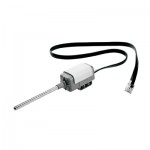 LEGO Education NXT Temperature Sensor (right). The approach was to boil a pot of water with the sensors hovering approx 1″ into the surface of the water and monitor the change on temperature over time to evaluate how the sensors handle rapid changes in temperature. I created an NXT-G program that monitors all 3 sensors and writes the temperature value to a file every second. The test was performed for 3 minutes which was sufficient to demonstrate the sensor response.
LEGO Education NXT Temperature Sensor (right). The approach was to boil a pot of water with the sensors hovering approx 1″ into the surface of the water and monitor the change on temperature over time to evaluate how the sensors handle rapid changes in temperature. I created an NXT-G program that monitors all 3 sensors and writes the temperature value to a file every second. The test was performed for 3 minutes which was sufficient to demonstrate the sensor response.
The NXT-g program was straight forward. Open a file for writing, run the sensor monitoring through a loop (running 180 seconds), write the values to the file, close the file, upload to Excel, create chart. Within the loop, I use the Text block to concatenate each temperature senor reading with a “,” to create a CSV formatted file for import. For example: Line 1: 20.5,20,21
(Download the NXT-g program here)
[ad name=”GoogleAS728x90ImgOnly”]
The following chart shows the response from all three sensors:
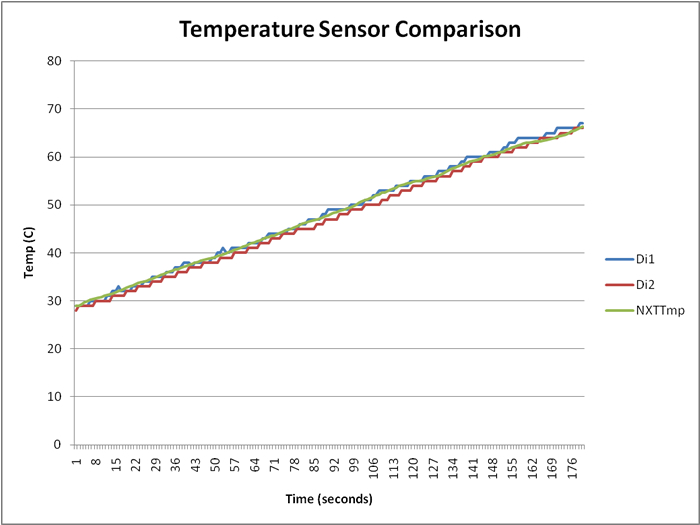
The legend shows Di1 (protected probe), Di2 (open probe) and the LEGO sensor. As the chart shows, all three sensors performed nearly identical in their ability to track temperature changes over time. It is also important to know that the LEGO NXT sensor reported its readings in 1/10th increments while the Dexter sensors reported their readings in whole degrees ( see update below). This would account for the less granular (or “stepped”) responses of the Dexter sensors. The LEGO sensor simply showed a finer change in temperature per second. It is also quite possible that the Dexter sensors may be able to report temperature readings tenths at a later time.
** Update ** – Dexter Industries has recently updated the NXT-G block with the ability to also track in 1/10th increments. I would expect that, if the test were run again, all 3 sensors would now show nearly identical results.
Conclusions:
Based on the above results, there is not much to worry about regarding sensor performance between the Dexter Industries sensors and the LEGO NXT sensor. It really comes down to price, features and usefulness. The LEGO NXT sensor is more expensive and will set you back about $40 USD. It has the ability to connect directly to NXT/Technic elements and the probe fits through the standard Technic beam hole. The Dexter sensors will run you about $25 USD, and does not have the ability to directly connect to NXT/Technic elements. However, it would be easy to mock something up to hold it. Both sensors will report readings using 1/10th increments.
Download the NXT-G block here. | Dexter Industries Temperature Probe Website

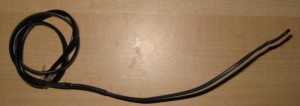
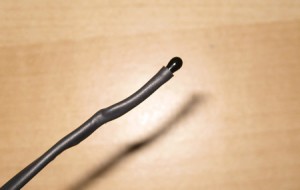





Hi
where did you get the Lego NXT-g Temperature block?
Thanks
I have the LEGO Education version of NXT-g. I believe it came with that distro.
Great review!
I just wanted to followup: as updated above, we offer an NXT-G 2.0 block that allows for 1/10th degree increments. The block can be found here: http://www.dexterindustries.com/files/DI_Temp_2.0.zip
Great stuff!
I have learn several excellent stuff here. Certainly price bookmarking for revisiting. I surprise how much effort you put to make the sort of great informative website.